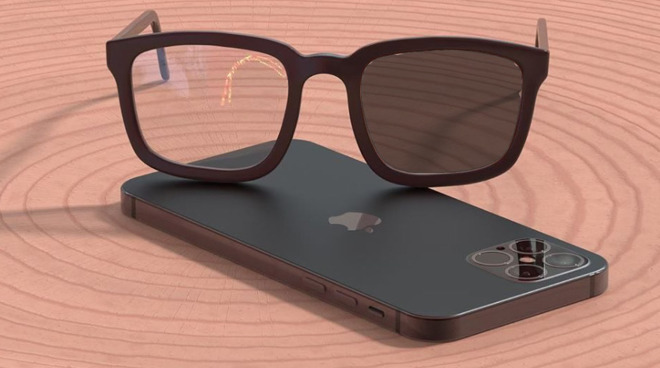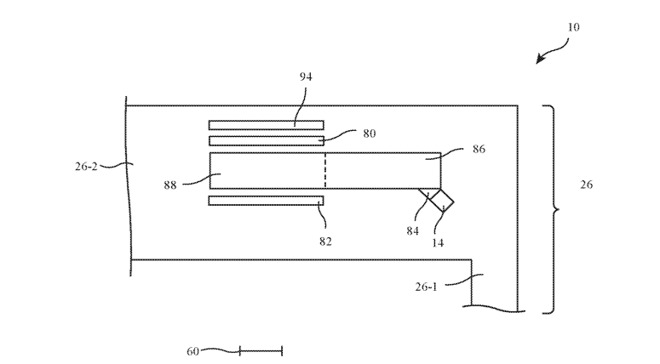'Apple Glass' may selectively darken to match AR elements with the real world
An "Apple Glass" lens with adjustable optics may be used to help AR objects appear to fit more realistically in the real-world environment.

The lenses in "Apple Glass" could be separately self-adjusting
Apple's research into headsets, such as "Apple Glass," has previously included the idea of lenses that adjust themselves. That idea meant users may never need prescription lenses, but now Apple is applying the idea of self-adjustment to help all users, regardless of their vision.
"Display System With Localized Optical Adjustments," is a newly-revealed patent application which focuses -- forgive the pun -- on how such lenses could change to better present AR objects.
"Electronic devices sometimes include adjustable optical components," says the patent application. "For example, wearable electronic devices such as head-mounted devices may include displays for displaying computer-generated content that is overlaid on real-world content."
"It may be desirable to place an adjustable optical component in line with a user's field of view," it continues. "The adjustable optical component may be used, for example to adjust real-world object brightness as a user is viewing computer-generated content that is overlaid on top of real-world objects."
Sometimes you want to know that the Pokemon in front of you is part of a game, and not really on the street. But if, for instance, AR displays comparative information cards for a shopper, then those being brighter than the surroundings is distracting.
Presumably an "Apple Glass" device could have the ability to sense the ambient lighting around a user and adjust the AR objects to match. If it can also adjust the brightness or darkness of the real world view seen through it, that would make it better able to present a consistent image.
"Challenges can arise when incorporating adjustable optical components into electronic devices," continues the patent application. "For example, adjustable optical components for head-mounted devices may be overly bulky or heavy."
"[Plus some] adjustable optical components have the potential to exhibit diffraction effects or other undesired effects that create visible artifacts," it says.

It's not the clearest patent diagram, but this shows a lens with multiple adjustable elements within it
Apple's proposal is to use an "electrically adjustable material" that "may include a transparent conductive material such as indium tin oxide that includes a pattern of segmented trenches."
"The trenches may be configured to provide the transparent conductive material with electrical anisotropy, so that the sheet resistance of the transparent conductive material is different in different directions," it continues. "This allows control circuitry to spatially control the voltage across the adjustable optical component."
Having lenses be so adjustable, and specifically adjustable under software control, also brings another benefit. Each lens can be adjusted to a different degree, for instance "used to create an image for a left-hand eye box," or a right-hand one.
So one lens might actually block a user's view of an object in favor of displaying information, while the other presents a view of the real-world that is adjusted to match brightness.
"The [lens] images may be guided," continues the patent application. "In this way, the left and right images may be transported from the left and right sides of [the] device towards locations in the center of device 10 that are aligned with left and right eye boxes."
That sounds closer to Apple's prior work on removing the need for prescription lenses. But it's all to do with providing high-quality images that are useful rather than distracting.

The lenses in "Apple Glass" could be separately self-adjusting
Apple's research into headsets, such as "Apple Glass," has previously included the idea of lenses that adjust themselves. That idea meant users may never need prescription lenses, but now Apple is applying the idea of self-adjustment to help all users, regardless of their vision.
"Display System With Localized Optical Adjustments," is a newly-revealed patent application which focuses -- forgive the pun -- on how such lenses could change to better present AR objects.
"Electronic devices sometimes include adjustable optical components," says the patent application. "For example, wearable electronic devices such as head-mounted devices may include displays for displaying computer-generated content that is overlaid on real-world content."
"It may be desirable to place an adjustable optical component in line with a user's field of view," it continues. "The adjustable optical component may be used, for example to adjust real-world object brightness as a user is viewing computer-generated content that is overlaid on top of real-world objects."
Sometimes you want to know that the Pokemon in front of you is part of a game, and not really on the street. But if, for instance, AR displays comparative information cards for a shopper, then those being brighter than the surroundings is distracting.
Presumably an "Apple Glass" device could have the ability to sense the ambient lighting around a user and adjust the AR objects to match. If it can also adjust the brightness or darkness of the real world view seen through it, that would make it better able to present a consistent image.
"Challenges can arise when incorporating adjustable optical components into electronic devices," continues the patent application. "For example, adjustable optical components for head-mounted devices may be overly bulky or heavy."
"[Plus some] adjustable optical components have the potential to exhibit diffraction effects or other undesired effects that create visible artifacts," it says.

It's not the clearest patent diagram, but this shows a lens with multiple adjustable elements within it
Apple's proposal is to use an "electrically adjustable material" that "may include a transparent conductive material such as indium tin oxide that includes a pattern of segmented trenches."
"The trenches may be configured to provide the transparent conductive material with electrical anisotropy, so that the sheet resistance of the transparent conductive material is different in different directions," it continues. "This allows control circuitry to spatially control the voltage across the adjustable optical component."
Having lenses be so adjustable, and specifically adjustable under software control, also brings another benefit. Each lens can be adjusted to a different degree, for instance "used to create an image for a left-hand eye box," or a right-hand one.
So one lens might actually block a user's view of an object in favor of displaying information, while the other presents a view of the real-world that is adjusted to match brightness.
"The [lens] images may be guided," continues the patent application. "In this way, the left and right images may be transported from the left and right sides of [the] device towards locations in the center of device 10 that are aligned with left and right eye boxes."
That sounds closer to Apple's prior work on removing the need for prescription lenses. But it's all to do with providing high-quality images that are useful rather than distracting.

Comments